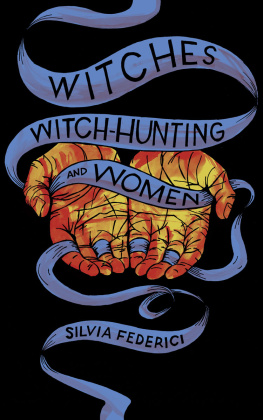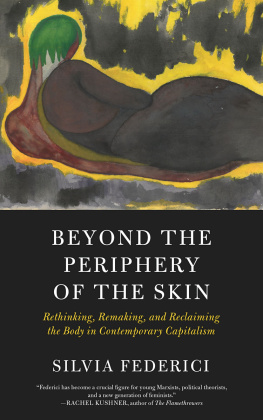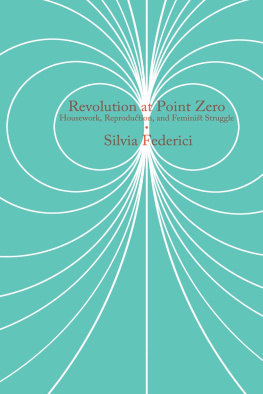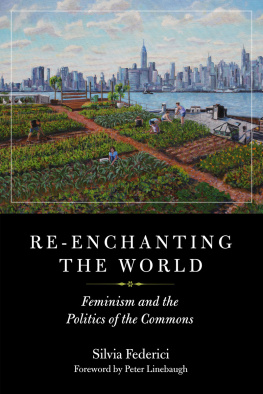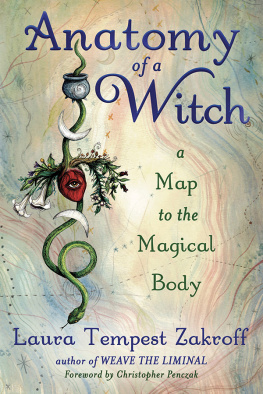Caliban and the Witch
by Silvia Federici
Acknowledgments
To the many witches I have met in the Women's Movement, and to the other witches whose stories have accompanied me for more than twenty-five years, nevertheless leaving an inexhaustible desire to tell, to let people know, to make sure that they will not be forgotten.
To our brother Jonathan Cohen whose love, courage and uncompromising resistance to injustice have helped me not lose faith in the possibility of changing the world and in men's ability to make the struggle for women's liberation their own.
To the people who have helped me to produce this volume. I thank George with whom I have discussed every aspect of this book; Mitchel Cohen for his excellent comments, his editing of parts of the manuscript, and his enthusiastic support for this project; Ousscina Alidou and Maria Sari for introducing me to the work of Maryse Conde; Ferruccio Gambino for making me aware of the existence of slavery in 16th- and 17th-century Italy; David Goldstein for the materials he has given me on the witches' "pharmakopeia"; Conrad Herold, for contributing to my research on witch hunting in Peru; Massimo de Angelis. for giving me his writings on primitive accumulation and for the important debate on this topic which he organized in The Commoner; Willy Murunga for the materials he has given me on the legal aspects of witchcraft in East Africa. I thank Michaela Brennan and Veena Viswantha for reading the manuscript and giving me advice and support. I also thank Mariarosa Dalla Costa, Nicholas Faraclas, Leopolda Fortunati, Everet Green, Peter Linebaugh. Bene Madunagu, Maria Mies, Ariel Salleh, Hakim Bey. Their works have been a reference point for the perspective that shapes Caliban and the Witches though they may not agree with all that I have written here.
Special thanks to Jim Fleming, Sue Ann Harkey, Ben Meyers and Erika Biddle, who have given many hours of their time to this book and, with their patience and assistance, have given me the possibility of finishing it, despite my endless procrastination. New York, April 2004
Autonomedia
POB 568 Williamsburgh Station, Brooklyn, NY 11211-0568 USA
www.autonomedia.org info@autonomedia.org
This work is licensed under the Creative Commons Attribution-Non Commercial 4.0 International License. To view a copy of this license, visit http://creativecommons.org/licenses/by-nc/4.0/ or send a letter to Creative Commons, 444 Castro Street, Suite 900, Mountain View, CA, 94041, USA.
Designed by Sue Ann Harkey
First edition, 2004. Second, revised edition, 2014.
ISBN 1-57027-059-7
Printed in the United States of America
A Note from the Transcription Team:
Caliban and the Witch, until a recent reprinting, has been very difficult to acquire outside of a poor quality scan available online. With the release of a new edition, we were able to purchase and make a new, much higher quality scan of this text. OCR was then applied to the document and it was manually edited to correct transcription errors and formatting. This is the result of these many, many hours of work.
This text was created using GitBook which allows us to track and version the entire text using git and the associated features. If you see errors, typos, or other issues, please create a discussion at our repo: https://www.gitbook.com/book/anarchivists/caliban/discussions. We'll do our best to correct errors quickly and update the text.
We encourage you to purchase this text if possible to support Ms. Federici and her important work.
If you have important or radical texts you'd like transcribed or are interested in contributing to these projects, please contact @anarchivists https://www.gitbook.com/@anarchivists.
A Note from an epub Editor:
Spellcheck found a few hundred errors, including formatting. Duplicate image (183) corrected. Proofread.

Preface
Caliban and the Witch presents the main themes of a research project on women in the "transition" from feudalism to capitalism that I began in the mid-1970s, in collaboration with an Italian feminist, Leopoldina Fortunati. Its first results appeared in a book that we published in Italy in 1984: Il Grande Calibano. Storial del corpo social ribelle nella prima fase del capitale (Milano: Franco Angeli) [The Great Caliban. History of the Rebel Body in the First Phase of Capitalism].
My interest in this research was originally motivated by the debates that accompanied the development of the Feminist Movement in the United States concerning the roots of women's "oppression," and the political strategies which the movement should adopt in the struggle for women's liberation. At the time, the leading theoretical and political perspectives from which the reality of sexual discrimination was analyzed were those proposed by the two main branches of the women's movement: the Radical Feminists and the Socialist Feminists. In my view, however, neither provided a satisfactory explanation of the roots of the social and economic exploitation of women. I objected to the Radical Feminists because of their tendency to account for sexual discrimination and patriarchal rule on the basis of transhistorical cultural structures, presumably operating independently of relations of production and class. Socialist Feminists, by contrast, recognized that the history of women cannot be separated from the history of specific systems of exploitation and, in their analyses, gave priority to women as workers in capitalist society. But the limit of their position, in my understanding of it at the time, was that it failed to acknowledge the sphere of reproduction as a source of value-creation and exploitation, and thus traced the roots of the power differential between women and men to women's exclusion from capitalist development a stand which again compelled us to rely on cultural schemes to account for the survival of sexism within the universe of capitalist relations.
It was in this context that the idea of tracing the history of women in the transition from feudalism to capitalism took forth. The thesis which inspired this research was first articulated by Mariarosa Dalla Costa and Selma James, as well as other activists in the Wages For Housework Movement, in a set of documents that in the 1970s were very controversial, but eventually reshaped the discourse on women, reproduction, and capitalism. The most influential among them were Mariarosa Dalla Costa's Women and the Subversion of the Community (1971), and Selma James' Sex, Race and Class (1975).
Against the Marxist orthodoxy, which explained women's "oppression" and subordination to men as a residuum of feudal relations, Dalla Costa and James argued that the exploitation of women has played a central function in the process of capitalist accumulation, insofar as women have been the producers and reproducers of the most essential capitalist commodity: labor-power. As Dalla Costa put it, women's unpaid labor in the home has been the pillar upon which the exploitation of the waged workers, "wage slavery," has been built, and the secret of its productivity (1972:31). Thus, the power between women and men in capitalist society cannot be attributed to the irrelevance of housework for capitalist accumulation an irrelevance belied by the strict rules that have governed women's lives nor to the survival of timeless cultural schemes. Rather, it should be interpreted as the effect of a social system of production that does not recognize the production and reproduction of the worker as a social-economic activity, and a source of capital accumulation, but mystifies it instead as a natural resource or a personal service, while profiting from the wageless condition of the labor involved.


